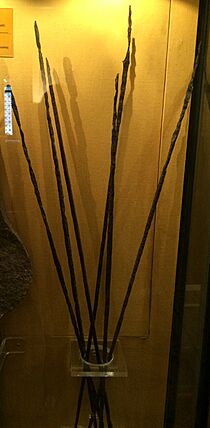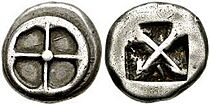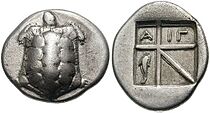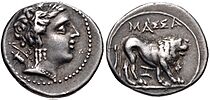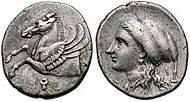Ancient drachma facts for kids
In ancient Greece, the drachma was an old type of money. Many Greek city-states used it for over 1,000 years. This was from the Archaic period (around 6th century BC) all the way to the Roman period.
The drachma coin was usually made of silver. Sometimes it was made of gold. It started from a system where people traded goods. A "drachma" first meant a handful of wooden or metal sticks. Each city-state made its own unique drachma coins. Some of these coins were used all over the Mediterranean Sea. The coins from Athens were the most popular and strongest.
Contents
How the Drachma Got its Name
The word drachma comes from the Greek verb drássomai. This means "(I) grasp" or "to hold in your hand." People believe the word meant "handful" in ancient times.
Originally, one drachma was a "fistful" or "grasp" of six oboloí. These were metal sticks, like small spits used for roasting meat. These oboloi were an early form of money. They started around 1100 BC. They were like metal bars (bronze, copper, or iron) that were weighed. This was part of a trading system.
The oldest obeloi were found in Cyprus. They were often buried with important people. Over 150 rod-shaped obeloi were found at the Heraion of Argos in Greece. Six of these are now in the Numismatic Museum of Athens.
The drachma became the main silver coin in most ancient Greek cities. An obol coin was worth one-sixth of a drachma. An ancient writer named Herakleides of Pontos (387–312 BC) wrote about this. He said that King Pheidon of Argos gave rod-shaped obeloi to a temple.
What Ancient Greek Coins Looked Like
Ancient Greek coins often had special names. For example, the Athenian tetradrachm was called an "owl." This was because it had an owl on it. The Aeginetic stater was called a "chelone" (turtle). The Corinthian stater was called a "hippos" (horse).
Each city made its own coins. They stamped them with symbols of their city. These symbols were like a city's badge. People often called the coins by the city's name or the image on them. The value of a coin depended on how much and what kind of metal it had. It also depended on how good the city's mint was. Most coins were silver, but a few were gold.
Where Drachmas Were Used
Many Greek cities used the drachma. Some of these included Athens, Corinth, Ephesus, and Syracuse. Most coins only stayed in the area where they were made. There was no single standard for all coins. However, more than half of the known Greek city-states did not make their own coins.
Larger and smaller versions of the drachma were also made. Ptolemaic Egypt made very large gold, silver, and bronze coins. After Alexander the Great's conquests, the name drachma spread. It was used in many kingdoms in the Middle East. This included the Ptolemaic kingdom in Egypt and the Parthian Empire (modern-day Iran).
The Arabic money unit called dirham got its name from the drachma. The dirham is still used today in Morocco and the United Arab Emirates. The Armenian dram also got its name from the drachma.
Athenian Owl Coins
The Athenian tetradrachm was a coin worth four drachmas. It was made in the 5th century BC. The front of the coin showed the head of Athena with a helmet. The back showed an owl. People called these coins "owls." There was a saying, "an owl to Athens." This meant something was already plentiful, like "bringing coals to Newcastle."
The owl image from the back of the tetradrachm is now on the modern Greek 1 euro coin. The Athenian tetradrachm was one of the most used coins in the Greek world. This was before Alexander the Great. Athenian coins were popular because they used very pure silver. Cities needed their coins to be valuable to be accepted widely. Athens's coins were accepted internationally.
The silver for Athenian coins came from the Laurium Mines. These mines were in Attica, near Athens. The Athenian government closely managed the mining. The historian Herodotus wrote about how much wealth Athens got from these mines.
How Drachmas Were Used in Ancient Greece
Historians debate the first use of coins. But there is evidence that coins were used for different things over time.
Most historians agree that coins helped with trade. Herodotus wrote that the Lydians were the first to make and use coins for buying and selling. Since trade was controlled by the state, trade and politics were closely linked.
Ancient coins also had religious uses. Obeloi (the metal sticks) were often given as gifts at temples. Evidence of this has been found at the Apollo sanctuary at Delphi and the Hera and Zeus sanctuary at Olympia. Coins were also used to pay fines or taxes to priests and temples.
Many historians think coins helped build empires. A Greek city-state could show its power by controlling its coins. Coins also showed civic pride. One historian compared coins to flags today. They were "symbols of sovereign identity."
Coins were also used as prizes at athletic games. These games were a big part of Greek life. Winners often got valuable prizes, including coins.
In daily life, coins were used for things like marriage and buying land. For example, Dowries (money or goods a bride brought to her marriage) were often paid in cash. A wealthy Athenian family might pay a dowry of "500 drachmas to 2 talents."
Value of the Drachma
Weight and Size
Drachmas were made with different weights in different Greek cities. The most common standard was the Athenian or Attic standard. This coin weighed a little over 4.3 grams.
The drachma was divided into six obols. Each obol weighed about 0.72 grams. Obols were then divided into four tetartemoria. These were very small coins, only about 5–7 mm wide.
What a Drachma Could Buy
It's hard to compare the value of ancient money to modern money. This is because economies and products were very different.
In ancient Greece (5th and 4th centuries BC), a skilled worker or a soldier (hoplite) earned one drachma per day. A juror (heliast) earned half a drachma per day after 425 BC. Before the Peloponnesian War (which started in 431 BC), a laborer might earn one-third of a drachma per day.
Some ancient writers suggested that half a drachma per day was enough for a poor family to live comfortably. For example, the writer Aristophanes mentioned that a juror's half-drachma was just enough for a family of three.
Food and clothing were expensive back then. A gallon of olive oil cost three drachmas. A cloak could cost anywhere from five to twenty drachmas.
Denominations of Ancient Greek Silver Coins
| Different Kinds of Greek Silver Coins | ||||
|---|---|---|---|---|
| Image | Coin Name | Value | Weight | Greek Name |
| Dekadrachm | 10 drachmae | 43 grams | Δεκάδραχμον | |
| Tetradrachm | 4 drachmae | 17.2 grams | Τετράδραχμον | |
| Didrachm | 2 drachmae | 8.6 grams | Δίδραχμον | |
| Drachma | 6 obols | 4.3 grams | Δραχμή | |
| Tetrobol | 4 obols | 2.85 grams | Τετρώβολον | |
| Triobol (hemidrachm) |
3 obols (1⁄2 drachma) |
2.15 grams | Τριώβολον (ἡμίδραχμον) |
|
| Diobol | 2 obols | 1.43 grams | Διώβολον | |
| Obol | 4 tetartemoria (1⁄6 drachma) |
0.72 grams | Ὀβολός (ὀβελός) |
|
| Tritartemorion | 3 tetartemoria | 0.54 grams | Τριταρτημόριον (τριτημόριον) |
|
| Hemiobol | 2 tetartemoria (1⁄2 obol) |
0.36 grams | Ἡμιωβέλιον (ἡμιωβόλιον) |
|
| Trihemitetartemorion | 1+1⁄2 tetartemorion | 0.27 grams | Τριημιτεταρτημόριον | |
| Tetartemorion | 1⁄4 obol | 0.18 grams | Τεταρτημόριον (ταρτημόριον, ταρτήμορον) |
|
| Hemitetartemorion | 1⁄2 tetartemorion | 0.09 grams | Ἡμιτεταρτημόριον | |
How Drachmas Were Divided
Ancient Greek currency had these divisions:
- 12 chalkoi = 1 obolus
- 6 oboloi = 1 drachma
- 70 drachmae = 1 mina (later 100 drachmae = 1 mina)
- 60 minae = 1 Athenian Talent (Athenian standard)
It's important to know that minae and talents were not actual coins. They were units of weight. They were used for measuring things like grain or metals such as silver and gold.
Drachma in Pop Culture
The drachma appears in stories and games today:
- In the video game Spy Fox in "Dry Cereal" (2008), drachma is the money used on a fictional Greek island.
- In Rick Riordan's Percy Jackson & the Olympians book series, the golden drachma is the main currency. It also appears in the spinoff The Heroes of Olympus.
- The drachma is used in the video games Assassin's Creed Origins (set in Ptolemaic Egypt) and Assassin's Creed Odyssey (set in Ancient Greece). Players can buy weapons and outfits with it.
See Also


